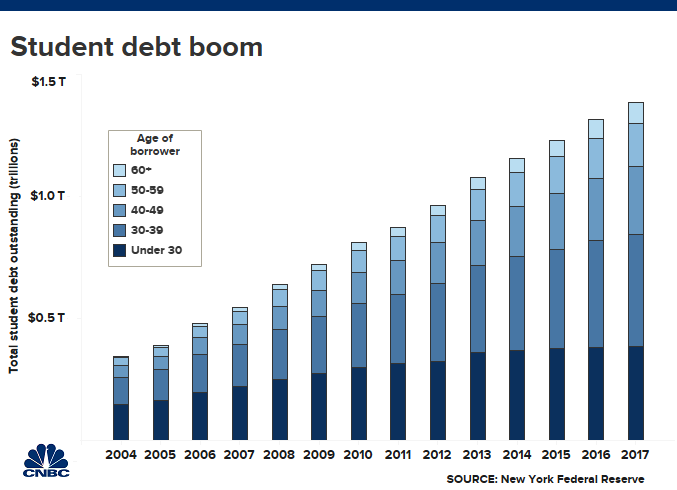CNBC | Jaden Urbi
Big changes could be coming down the pipeline for the 44 million Americans with student debt.
Presidential campaign proposals and recently introduced legislation aim to rewrite the rules around student loan interest, repayment and refinancing.
Some of the plans would reduce — or altogether erase — people’s balances.
More from Personal Finance:
Losses at Fisher Investments hit $1.8 billion as Fidelity exits
The 10 best places to vacation on a budget
Tips to get your Medicare drug coverage right
It’s no surprise politicians have turned their attention to the topic: More than half of Americans say student debt is “a major problem” for the country, according to a Politico/Morning Consult poll.
Outstanding education debt has outpaced credit card and auto debt. The average college graduate leaves school $30,000 in the red today, up from $10,000 in the 1990s. Every day, 3,000 borrowers go into default.
Which proposals come to fruition remains to be seen, but one thing is clear: As discontent with the current system remains, discussions about changing it will, too, wear on.
A fresh start
U.S. Representative Alexandria Ocasio-Cortez & U.S. Senator Bernie Sanders on stage at Bernie Sanders Rally “Bernie’s Back” in Queensbridge Park. She endorses him for President of USA.
Lev Radin | LightRocket | Getty Images
Most people struggling with student loans probably didn’t imagine debt forgiveness could be in their future. Now, leading presidential candidates are calling for such a reset.
Bernie Sanders has proposed wiping out the country’s $1.6 trillion outstanding student loan tab. Essentially, all borrowers would be freed from their debt. “This is truly a revolutionary proposal,” Sanders told The Washington Post.
Under Elizabeth Warren’s plan, borrowers with household incomes of less than $100,000 would get $50,000 of their student debt forgiven. People who earn between $100,000 and $250,000 would be eligible for forgiveness on a sliding scale – that $50,000 in debt relief drops by $1 for every $3 a person earns over $100,000. And those who earn more than $250,000 would be ineligible for debt forgiveness.
At a recent campaign event, Kamala Harris hinted that she’d be rolling out a plan soon to forgive the student loan debt of families who earn less than $100,000 a year.
This week a senior government official appointed by Education Secretary Betsy DeVos resigned, saying the current student loan system is “fundamentally broken” and calling for billions of dollars in debt to be forgiven.
A. Wayne Johnson proposes to forgive $50,000 in student debt for all borrowers, about $925 billion. “It’s the first Republican support for widespread student loan forgiveness,” said Mark Kantrowitz, a higher education expert. “That makes it a bipartisan issue.”
Higher Education Act
Every four or five years, The Higher Education Act, which controls the shape and scope of federal student aid, is updated. It’s gone more than a decade without a tweak this round, making the changes likely to be rolled out next year highly anticipated.
House Democrats introduced this month their plan to overhaul the bill. “I think it’s a really constructive first step toward reauthorization,” said James Kvaal, president of the Institute for College Access & Success. “There’s a lot of potential common ground in the bill, particularly around student loan issues.”
Republicans and Democrats have shown interest in reducing the number of repayment plans to just two — there are currently 14 ways to repay your student loans, a complicated system critics say lead to needless defaults.
One plan would simply spread a borrower’s monthly payments across a decade. The other would cap monthly payments at a percentage of a borrower’s income, and their repayment timeline could be 20 or more years.
There is also bipartisan support for eliminating the origination fees on student loans. “It doesn’t make sense that if you borrow $1 for college, the check is actually 99 cents,” Kvaal said.

Democrats want to cut interest rates on student loans and make it easier for borrowers to refinance their debt. They also want to allow people who’ve climbed out of default to get their credit reports cleared of the incident.
At least one Republican, in addition to a host of Democratic lawmakers and presidential candidates, wants to allow student debt to be discharged in normal bankruptcy proceedings. Currently, borrowers can have to exhibit a “certainty of hopelessness” to walk away from their student debt in court.
Federal Reserve chairman Jerome Powell has said he’s “at a loss to explain” why student loans are treated differently than other types of debt in bankruptcy.
There’s no sound reason that struggling student loan borrowers shouldn’t be able to get a fresh start, Kantrowitz said.
“Credit cards can be discharged, but not student loans?” he said.
